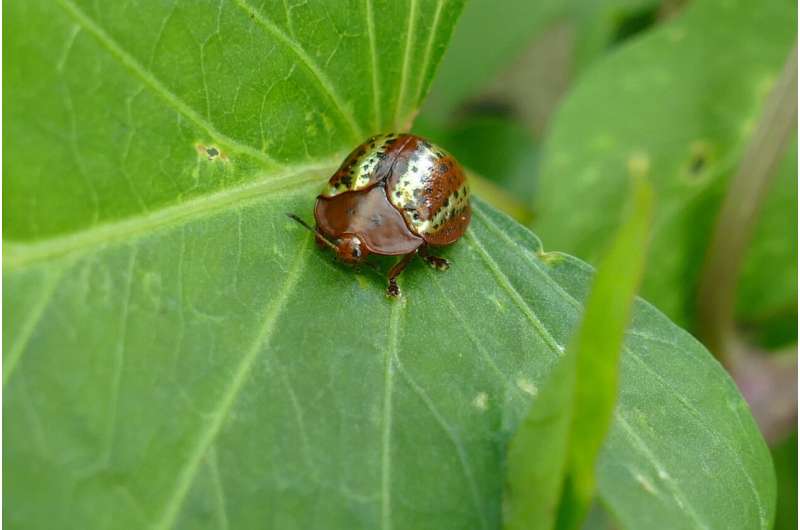This article has been reviewed according to Science X's editorial process and policies. Editors have highlighted the following attributes while ensuring the content's credibility:
fact-checked
trusted source
proofread
Researchers discover Paleocene origin of symbiotic relationships in leaf beetles

Brightly colored beetles that feed on a wide range of plants possess robust metabolic capabilities, thanks to bacteria residing in specialized organs in their digestive tract. The bacterium Stammera provides essential enzymes enabling Cassidinae beetles to digest plant cell wall components efficiently.
Researchers from the Max Planck Institute for Biology in Tübingen discovered the ancient origin of this specialized relationship. They found symbiotic leaf beetles exhibit greater species diversity than their non-symbiotic relatives. These findings, exposing the timing of symbiosis dating back 62 million years and its pivotal role in adaptation, are published in Current Biology.
In ecosystems such as the rainforests of Panama—a biodiversity hotspot—leaf beetles represent a prime example of mutualism, wherein two distinct species collaborate to adapt to challenging environments by sharing, rather than competing for, the same resources. Complementarity between symbiont and host represents the metabolic basis of the interaction, specifically as it relates to the deconstruction of the plant cell wall.
"I was curious to explore how widespread this symbiosis is, if its metabolic capabilities are shared across species and how this impacts their role in the natural habitat," said Marleny García-Lozano, doctoral researcher and lead author of the study.
The Max Planck Research Group on Mutualisms collaborated with researchers in Japan, the Netherlands, and Panama, including Dr. Donald Windsor, a renowned expert on leaf beetles from the Smithsonian Tropical Research Institute. The researchers ventured into the field to collect these intriguing insects to complement their genomic and molecular dissection of the interaction in the laboratory.
In 2017, Dr. Hassan Salem, Max Planck Research Group Leader and senior author of the study, first identified the bacterium's primary function as producing pectinase enzymes, crucial for digesting leaf food, as leaf beetles lack the required enzymes for this process.
Dr. Salem says, "Microbes can play an outsized role in our study of how animals radiate into new environments. Taking into account the metabolic potential of animals and their microbes is crucial for studying adaptation holistically."
Without the cell wall-degrading enzymes provided by Stammera, whose genome has been streamlined to less than 0.3 Mb, the beetle's digestive physiology would be incapable of digesting plant material, depriving them of essential nutrients.
"They are in an obligate relationship. The bacteria cannot survive without the insect, and if we remove them from the insect, the beetle will die within a few days," says García-Lozano. The symbiotic microbe Stammera adjusts the expression of genes encoding the digestive enzymes to align with its host's specific needs through development. Consequently, Stammera produces the necessary enzymes catering to the nutritional requirements of the host organism, thereby enhancing their overall vigor.
Unveiling the symbiotic relationship
The researchers were surprised that not all beetles contained this obligatory symbiosis when the 6,000 species of Cassidinae clade originated, despite its essential role insect digestion and growth.
The study reveals that Stammera acquisition by leaf beetles occurred during the Paleocene, approximately 62 million years ago (Mya). Understanding when the host acquired this symbiont emphasizes the historical context, the co-evolutionary processes, and the implications for adaptation resulting from symbiotic partnerships.
Overall, this comprehensive exploration of insect symbiotic relationships, combining complementary approaches—from analytical chemistry to genomics and field assays to molecular evolution with a paleontological context—underlines molecular interactions' vital role in shaping insect species' diversity and ecological networks. Protecting and maintaining ecosystem health and resilience is central to understanding the intricate interactions among insects, plants, and microorganisms.
More information: Marleny García-Lozano et al, Paleocene origin of a streamlined digestive symbiosis in leaf beetles, Current Biology (2024). DOI: 10.1016/j.cub.2024.01.070
Provided by Max Planck Society




















